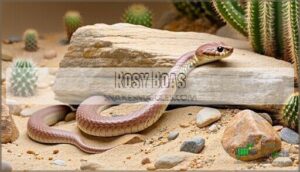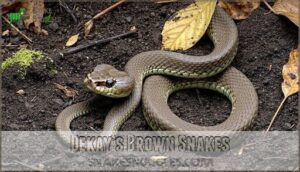This site is supported by our readers. We may earn a commission, at no cost to you, if you purchase through links.

Corn snakes will strike at thawed mice with the same enthusiasm as wild rodents, while some finicky species demand live prey or specific conditions that test even experienced keepers.
Eight species stand out for their reliable appetites and willingness to adapt to captive feeding schedules. These easy-to-feed snake species transform your first reptile experience from constant worry into straightforward care routines that build confidence with each successful meal.
Table Of Contents
Key Takeaways
- Corn snakes, ball pythons, and six other species consistently accept frozen-thawed prey without the feeding refusals that cause most beginners to abandon their snakes within the first year.
- Successful feeding depends on four key traits: willingness to accept pre-killed prey, calm temperament during handling, consistent feeding response, and manageable adult size under five feet.
- Proper feeding technique requires warming frozen-thawed prey to approximately 100°F, using tongs to prevent bite injuries, and matching prey width to the snake’s girth rather than length.
- Creating the right environment—including a 40-gallon enclosure with proper temperature gradients (85-90°F warm side, 75-80°F cool side) and 40-60% humidity—directly impacts feeding success and prevents stress-related meal refusals.
Top Easy-to-Feed Snake Species
Choosing the right snake starts with understanding which species are naturally enthusiastic eaters. The snakes below are known for their reliable feeding responses and willingness to accept frozen-thawed prey, making them ideal for first-time keepers.
Each offers a combination of manageable size, calm temperament, and straightforward care requirements.
Corn Snakes
Corn snakes have earned their reputation as the go-to starter snake because they’re practically bulletproof in terms of feeding—rarely refusing a meal and accepting frozen-thawed prey without the fuss that trips up other species.
You’ll find corn snake morphs in striking patterns, making them visually appealing, and their calm temperament means interaction won’t stress them out during feeding time.
They’re forgiving of beginner mistakes in snake care, consistently eating every 5-7 days as juveniles.
Ball Pythons
Ball pythons match corn snakes in beginner-friendliness but bring their own quirk to the table—they’re notorious for occasional fasting streaks that can rattle new keepers, even though they’ll readily accept frozen-thawed prey once they decide it’s mealtime.
Their calm temperament concerns are minimal, making them easy to feed snakes for beginners who want a hands-on pet.
You’ll appreciate the vast morph variations available and their breeding potential if you’re interested in advancing your snake care skills.
Kenyan Sand Boas
Kenyan sand boas offer something ball pythons don’t—they’re burrowing specialists with charming, gentle behavior that makes feeding straightforward since they rarely refuse frozen-thawed mice.
Your small snakes won’t demand much space, and their burrowing behavior means you’ll need proper enclosure substrate like aspen shavings. Here’s what makes them easy to feed snakes for any beginner snake keeper:
- They accept frozen-thawed prey without fuss
- Sand boa morphs add visual variety to your collection
- Their compact size simplifies snake feeding logistics
- Maintain a proper temperature gradient to prevent shedding problems
Rosy Boas
Rosy boas bring the boa constrictor experience down to a manageable size—you’ll get docile interaction and reliable feeding without needing an enclosure that takes over your living room.
These small snakes accept frozen-thawed prey consistently, making them easy to feed for any beginner snake keeper.
You’ll find rosy boa morphs in striking coastal and desert variations, and their calm temperament differences mean straightforward interaction techniques without the fuss.
African House Snakes
African house snakes won’t make you wait long at feeding time—they strike at frozen-thawed prey with enthusiasm that makes weekly meals feel uncomplicated. Their rodent diet and consistent feeding habits suit any beginner snake keeper looking for reliability.
You’ll appreciate their medium size and straightforward housing needs, while varied color morphs add visual interest.
Interaction advice is simple—these snakes stay calm during interaction, reinforcing why they’re an easy to feed choice.
Dekay’s Brown Snakes
If you’re looking for a snake that fits in a shoebox and eats like clockwork, Dekay’s brown snakes deliver simplicity without the fuss. Their natural diet of slugs and earthworms keeps feeding straightforward, while their small size means minimal space requirements.
- Temperament traits lean toward calm, though interaction concerns arise from their delicate build
- Habitat enrichment can include shallow substrate for burrowing behavior
- Brumation needs support natural seasonal cycles in captivity
- These beginner snake species prove that easy to feed small snakes don’t require rodent prey
Garter Snakes
Garter snakes stand out as one of the most adaptable reptiles you’ll encounter, thriving on a diet that ranges from fish and earthworms to pinky mice. This varied garter diet makes feeding straightforward for beginners, while their resilient nature means you won’t stress over finicky eating habits.
These small snakes accept multiple prey types, and their color morphs add visual interest without complicating care requirements.
Children’s Pythons
Children’s pythons offer the appeal of a ball python in a compact package, rarely exceeding three feet and accepting frozen-thawed prey with minimal fuss.
This dwarf python species displays a calm temperament that makes them easy to pick up, while their small size means a 30-gallon enclosure with basic enrichment satisfies their needs.
You’ll find morph variations available, and their consistent feeding response makes them an easy-to-feed beginner snake.
Key Traits of Easy-Feeding Snakes
Not all snakes make feeding time easy, but the best beginner species share a few key traits that simplify care.
These characteristics help you avoid common feeding challenges and build confidence as a new keeper.
Let’s look at what makes a snake truly beginner-friendly regarding mealtime.
Willingness to Accept Frozen-Thawed Prey
One of the biggest hurdles you’ll face is getting your snake to accept frozen-thawed prey, but the good news is that most easy-to-feed snake species adapt well with proper adjustment techniques. Almost all captive snakes can be trained to take pre-killed alternatives, with ball pythons showing 70% acceptance rates when you use enhanced prey preparation methods. Snakes in captivity thrive when fed frozen/thawed rodents.
- Warm prey to approximately 100°F before offering to trigger natural feeding responses
- Add bedding or scents from live rodents to frozen-thawed prey to mimic natural cues
- Avoid refreezing uneaten prey to prevent bacterial contamination and appetite loss
- Rule out environmental issues like incorrect temperature or humidity if you encounter feeding challenges or refusal reasons
Ethical considerations aside, frozen-thawed prey eliminates injury risks from defensive rodents and kills parasites that cause illness.
Calm Temperament and Handling
A snake’s personality matters just as much as its diet—interacting with a defensive, high-strung reptile can turn routine care into a nerve-wracking ordeal, especially when you’re just starting out. Beginner snake species like corn snakes and ball pythons are docile by nature, which builds your confidence during safe interaction. Gentle interaction reduces stress for both you and your pet, making easy-to-care-for snakes the smart choice when you’re learning proper snake temperament basics.
| Species | Temperament Rating |
|---|---|
| Corn Snake | Calm, rarely defensive |
| Ball Python | Gentle, tolerant |
| Rosy Boa | Extremely docile |
| Kenyan Sand Boa | Calm, rarely bites |
| Garter Snake | Active, generally peaceful |
Consistent Feeding Response
You’ve got a friendly snake that tolerates being held, but if it refuses meals week after week, you’re left second-guessing everything from cage temperature to prey choice. Easy-feeding species consistently accept frozen-thawed prey without requiring scenting prey or risky live feeding. Recognizing hunger signs and sticking to a proper feeding schedule prevents both appetite loss and obesity risks.
- Watch for increased activity and tongue flicking as clear hunger signs
- Adjust your feeding frequency based on the snake’s age and feeding schedule
- Avoid force-feeding by addressing refusal reasons like stress or improper temperatures
- Consistent eaters reduce feeding difficulties and simplify routine care
Appropriate Size for Beginners
Reliable feeding habits won’t do you much good if your new snake outgrows your space in six months or feels too delicate to confidently hold. Beginner-friendly snakes stay under five feet, require manageable prey size, and tolerate gentle interaction without stress. You’ll avoid feeding challenges and regurgitation risks when prey size appropriateness matches your snake’s body diameter, ensuring safe digestion every time.
| Species | Snake Length | Tank Size | Prey Size | Handling Ease |
|---|---|---|---|---|
| Corn Snake | 3–5 feet | 40 gallons | Adult mice | Very easy |
| Ball Python | 3–5 feet | 40 gallons | Small rats | Very easy |
| Kenyan Sand Boa | 2–3 feet | 30 gallons | Adult mice | Easy |
| Rosy Boa | 2–3 feet | 30 gallons | Adult mice | Easy |
| Children’s Python | 2.5–3 feet | 30 gallons | Adult mice | Easy |
Space requirements stay reasonable when you choose species that mature at manageable sizes, letting you focus on proper care instead of constant upgrades.
Safe and Simple Feeding Methods
Feeding your snake doesn’t have to be complicated, but using the right techniques makes the process safer for both you and your pet. The method you choose, how you prepare the prey, and the environment you create all affect your snake’s feeding response.
Let’s look at four practical approaches that work well for beginners.
Using Tongs Vs. Dropping Food
Both feeding tongs and dropping food are safe feeding methods, but tongs offer better injury prevention and reduce bacteria transfer from your hands. Using feeding tongs keeps your fingers away from your snake during strikes, preventing mistaken bites that signal feeding aggression. Here’s what makes tongs the safer choice:
- Tongs safety: You control prey presentation without risking accidental strikes to your hand.
- Clean feeding techniques: Metal or bamboo tongs prevent bacteria transfer that bare hands might introduce.
- Predictable response: Your snake learns to associate tongs with food, not your scent.
Dropping food works for calm eaters but won’t protect you during enthusiastic feeding responses.
Preparing Frozen-Thawed Prey
Proper thawing prevents bacterial growth and ensures your snake receives safe, room-temperature prey that mimics natural feeding conditions. Thaw frozen-thawed prey in a sealed bag submerged in warm water for 20-30 minutes—this thawing method preserves nutritional retention while preventing contamination. Never use microwaves, as they create hot spots that damage tissue.
After thawing, warm the prey’s head and body under warm tap water to trigger your snake’s heat-sensing response. Secure procedure means keeping prekilled alternatives sealed until feeding time, ensuring your easy-to-feed snake species gets meals that support peak health.
Choosing The Right Prey Size
The gap between your snake’s widest point and its meal determines whether digestion flows smoothly or becomes a dangerous struggle. Select prey that matches your snake’s girth—not length—to guarantee digestion ease and minimize regurgitation risk.
Juveniles thrive on appropriately sized frozen-thawed prey every 5-7 days, while adults need whole prey matching their body width every 10-14 days. Prey weight directly influences growth rate, so measure carefully before each feeding.
Creating a Stress-Free Feeding Environment
If your snake feels exposed or threatened during mealtime, even the hungriest individual may refuse to eat or regurgitate afterward. Quiet feeding spaces with dim lighting allow your snake to focus on hunger cues without distractions. Reduce movement near the enclosure and avoid touching before meals to prevent stress-related feeding refusals.
Safe feeding practices for snake health include:
- Providing hiding spots within view of prey placement
- Maintaining dim lighting during feeding sessions
- Eliminating loud noises or sudden movements nearby
- Waiting 48 hours after interacting with them before offering food
Feeding Schedules and Dietary Needs
Getting your snake’s feeding schedule right matters more than you might think. Young snakes need food more often than adults, and different species have their own rhythms.
Understanding these patterns—along with what your snake actually needs in its diet—will help you avoid common feeding problems before they start.
Feeding Frequency by Age and Species
Hatchling feeding demands attention—most beginner-friendly species need meals every 5–7 days when young. Corn snakes and ball pythons follow this pattern, while garter snakes require feeding every other day.
As juveniles mature, feeding schedules stretch to weekly or biweekly intervals. Adults usually eat every 10–21 days, though garter snakes maintain weekly feeding. Obesity prevention requires adjusting adult intervals based on body condition and seasonal adjustments in activity.
Corn snakes benefit from frozen rodents as a convenient food source.
Recognizing Hunger Signs
Snakes won’t ring a dinner bell, but their body language speaks volumes if you know what to look for. Increased activity levels and restless weaving along enclosure walls signal hunger. Watch for heightened tongue flicking frequency as your snake samples the air for prey.
Beginner snake keepers should note that shedding temporarily suppresses feeding response—wait until the process completes. Seasonal changes also affect appetite, with some species reducing intake during cooler months despite showing typical hunger signs.
Whole Prey as a Balanced Diet
Your snake’s prey isn’t just a meal—it’s a complete nutritional package, bones and all. Whole prey delivers everything captive snakes need—calcium from bone consumption, vitamins from organs, and protein from muscle tissue. This nutritional completeness eliminates supplement guesswork.
Rotating between mice and rats provides prey variety that mirrors wild rodent diets. Your snake’s digestion efficiency processes fur, bones, and tissue naturally, making whole prey the ideal approach for snake feeding.
Troubleshooting Feeding Issues
Even with whole prey diets, refusal occasionally occurs. Temperature issues top the list—enclosures below species-specific gradients reduce feeding response dramatically. Prey size mismatches trigger refusal too; switch to smaller items if your snake ignores meals.
Breeding season fasting, especially February through May in males, resolves naturally without intervention.
Health problems like respiratory infections or parasites need veterinary attention when weight loss accompanies appetite loss.
Space feeding attempts 7–14 days apart to minimize stress and improve acceptance.
Essential Care Tips for Beginner Snakes
Feeding your snake properly is just one piece of the puzzle. Beyond the dinner plate, you’ll need to create a living space that fosters their health, comfort, and natural behaviors.
Here’s what every beginner should focus on to keep their snake thriving.
Enclosure Size and Setup
Setting up the right enclosure isn’t just about picking a tank—it’s about building a home where your snake can feel secure, move comfortably, and display natural behaviors.
Most beginner snake species thrive in a 40-gallon terrarium with appropriate substrate options like aspen or cypress mulch.
Your snake enclosure setup should include at least two hiding spots, a stable heating setup on one end, and constant water access for drinking and soaking.
Temperature and Humidity Control
Without the right thermal gradient and moisture levels, even a perfectly sized tank becomes a risky environment for your snake. You’ll need a heat lamp or heating pad to create basking temperatures around 85–90°F on the warm side, with the cool end at 75–80°F.
Most beginner species need humidity between 40–60%, monitored with a reliable hygrometer. During shedding, slightly raise moisture levels to support healthy skin removal.
Handling and Stress Prevention
Picking up a snake too soon after adjusting its temperature and humidity can undo all your careful setup work by triggering stress responses that affect feeding and overall health. Wait 48–72 hours after setup before attempting any interaction. When you’re ready, follow these safe interaction steps:
- Support the body gently—don’t grab or squeeze
- Watch for defensive postures like coiling tight
- Keep sessions under 10 minutes initially
- Wash hands before touching to remove food scents
- Avoid touching during shedding periods
Reading behavior helps you recognize stress early and prevent bites through proper snake stress management.
Regular Health Monitoring
Weekly check-ins catch health problems before they escalate into serious complications that could have been prevented with early intervention.
Check your snake’s eyes for clarity, skin for scale rot or shedding issues, and breathing for respiratory infections. Weight monitoring helps detect parasites early.
Look for lumps, mouth discoloration, or lethargy—signs that warrant a vet visit to protect your snake’s health and wellbeing.
Frequently Asked Questions (FAQs)
Can snakes eat live prey safely?
Live prey carries real danger—rodents can bite or scratch your snake, causing wounds or stress.
Live prey poses real danger—rodents can bite or scratch your snake, causing injury and stress
Frozen-thawed prey eliminates injury risk while providing complete nutrition, making it the safer, more humane choice for both predator and prey.
How long after feeding should I handle?
Wait at least 48 hours after feeding before picking up your snake. Digestion time varies by species and meal size, but this timeframe reduces regurgitation risk and stress from being picked up.
Watch for safe digestion signs like reduced activity and a calm belly before safe interaction resumes.
What if my snake refuses frozen prey?
Try scenting prey with chicken broth or rubbing it with a thawed pinkie. Some snakes respond better to warmer prey presentation or braining—exposing brain matter to release scent.
If frozen-thawed prey consistently fails, consult your veterinarian before considering live feeding, which carries injury risks.
Do different snake colors require different diets?
Like choosing paint for a car rather than fuel for the engine, snake color doesn’t dictate diet. Color morphs—whether albinism, melanism, or other pigment variations—don’t change snake species diet or snake feeding requirements.
Snake care and snake species determine nutritional needs, not genetics-linked coloration.
Should I feed inside or outside enclosure?
Most keepers feed inside the enclosure to minimize escape risks and snake stress. Removing your snake for feeding can increase caretaker safety concerns and enclosure contamination elsewhere, but feeding practices vary based on individual needs and feeding environment preferences.
Conclusion
An ounce of prevention is worth a pound of cure"—this wisdom holds especially true when selecting your first snake. Choosing one of these easy-to-feed snake species eliminates the most common obstacle beginners face: anxious nights wondering if your pet will ever eat again.
Corn snakes, ball pythons, and their reliable counterparts transform feeding time from a source of stress into a predictable routine. Start with a species that feeds willingly, and you’ll build the confidence needed to expand your reptile-keeping journey.
- https://www.researchgate.net/publication/249322947_Female_breeding_frequency_clutch_size_and_dietary_habits_of_a_Nigerian_population_of_Calabar_ground_python_Calabaria_reinhardtii
- https://portal.ct.gov/-/media/DEEP/wildlife/pdf_files/outreach/fact_sheets/brownsnakepdf.pdf
- https://www.snakesociety.nl/jaargangen/1986e/Litteratura%20Serpentium%206-3%20098-106%20vdPols,%20Husbandry%20and%20breeding%20of%20Lichanura%20trivirgata%20roseofusca.pdf
- https://paradepets.com/pet-news/best-small-animal-breeds-for-first-time-pet-owners-according-to-a-vet
- https://www.thesprucepets.com/snake-species-1239472


















